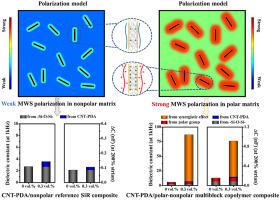Composites Part B: Engineering ( IF 12.7 ) Pub Date : 2021-06-24 , DOI: 10.1016/j.compositesb.2021.109103 Xueying Liu , Haibin Sun , Suting Liu , Yingjie Jiang , Zhengming Yin , Bing Yu , Nanying Ning , Ming Tian , Liqun Zhang

|
The application of silicone rubber as dielectric elastomer sensor is limited by its poor strain sensing performance because of low dielectric constant (ε′). In this study, we designed and fabricated a fluorosilicone dielectric composite with high ε′ and capacitive strain sensing performance by designing polar-nonpolar multiblock fluorosilicone copolymer and introducing poly(dopamine)-modified nanotubes (CNT-PDA). Firstly, a polar (bis(3-aminopropyl)-terminated poly(3,3,3-trifluoropropyl) methylsiloxane (H2N-PFMS-NH2)) and a nonpolar (bis(3-aminopropyl)-terminated poly(dimethylsiloxane) (H2N-PDMS-NH2)) silicone oligomers were synthesized by anionic ring opening polymerization. Then, a series of PFMS/PDMS multiblock copolymer were synthesized through a one-pot polycondensation reaction between isocyanate groups from methylene-bis(4-cyclohexylisocyanate) and amino groups from the as prepared H2N-PFMS-NH2 and H2N-PDMS-NH2. The hydrogen bonds between urea groups act as physical crosslinking points on the multiblock copolymer. The H2N-PFMS-NH2 chains with polar CF3 groups contribute to high dipole polarizability and thus a high ε’. A strong interfacial adhesion between CNT-PDA and the multiblock copolymer was obtained by hydrogen bonding between the urea groups of the multiblock copolymer and CNT-PDA, resulting in strong interfacial polarizability. The as-prepared composite exhibits a ε′ of about 86.7 at 103 Hz and a capacitance change (ΔC) of about 0.91 nF at 200% strain at only 0.3 vol% of CNT-PDA, which was increased by 23.8 and 8.1 times, respectively, compared with the CNT-PDA/commercial nonpolar reference SiR composites. The largely improved ε′ and capacitive strain sensing properties are mainly attributed to the synergistic polarization effect, which was discussed based on impedance analysis and calculating the contribution of each composition on ε’ and ΔC.
中文翻译:

通过设计极性-非极性氟硅氧烷多嵌段共聚物并引入聚(多巴胺)改性的碳纳米管,具有高介电常数和电容应变传感特性的介电弹性体传感器
由于介电常数(ε')低,硅橡胶作为介电弹性体传感器的应用受到其应变传感性能差的限制。在这项研究中,我们通过设计极性-非极性多嵌段氟硅氧烷共聚物并引入聚(多巴胺)改性纳米管(CNT-PDA),设计并制造了具有高 ε' 和电容应变传感性能的氟硅氧烷介电复合材料。首先,极性(双(3-氨基丙基)末端聚(3,3,3-三氟丙基)甲基硅氧烷(H 2 N-PFMS-NH 2))和非极性(双(3-氨基丙基)末端聚(二甲基硅氧烷) ) (H 2 N-PDMS-NH 2)) 有机硅低聚物是通过阴离子开环聚合合成的。然后,通过亚甲基-双(4-环己基异氰酸酯)的异氰酸酯基团与制备的 H 2 N-PFMS-NH 2和 H 2 N 的氨基之间的一锅缩聚反应合成了一系列 PFMS/PDMS 多嵌段共聚物。-PDMS-NH 2。脲基之间的氢键充当多嵌段共聚物上的物理交联点。具有极性 CF 3的 H 2 N-PFMS-NH 2链基团有助于高偶极极化率,从而导致高 ε'。CNT-PDA和多嵌段共聚物之间的强界面粘附是通过多嵌段共聚物和CNT-PDA的脲基团之间的氢键形成的,从而产生很强的界面极化性。所制备的复合材料在 10 3 Hz 下显示出约 86.7 的 ε'和在 200% 应变下仅 0.3 vol% CNT-PDA 的电容变化 (ΔC) 约为 0.91 nF,增加了 23.8 和 8.1 倍,分别与 CNT-PDA/商业非极性参考 SiR 复合材料进行比较。ε' 和电容应变传感特性的大幅改善主要归因于协同极化效应,这是基于阻抗分析和计算每种成分对 ε' 和 ΔC 的贡献进行讨论的。











































 京公网安备 11010802027423号
京公网安备 11010802027423号